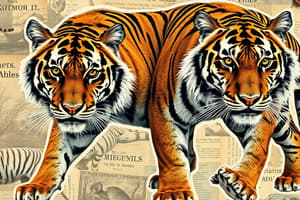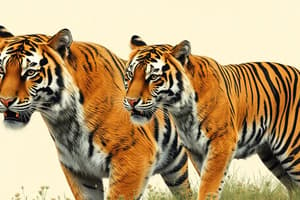Podcast
Questions and Answers
What was the primary reason for releasing Boris and Svetlaya in separate areas initially?
What was the primary reason for releasing Boris and Svetlaya in separate areas initially?
- To encourage the tigers to develop stronger hunting skills independently.
- To observe their individual adaptation capabilities in different environments.
- To minimize the risk of territorial disputes between the two tigers.
- To expand the distribution of the endangered species across a larger habitat. (correct)
How did the conservation center prepare Boris and Svetlaya for their eventual release into the wild?
How did the conservation center prepare Boris and Svetlaya for their eventual release into the wild?
- By training them to hunt specific types of prey found in their natural habitat.
- By providing them with a controlled diet of wild-sourced meat.
- By gradually exposing them to human interaction to reduce fear.
- By housing them in large, open enclosures with minimal human contact. (correct)
What key finding did the scientists publish in the Journal of Wildlife Management?
What key finding did the scientists publish in the Journal of Wildlife Management?
- The discovery of a new Amur tiger subspecies in the Sikhote-Alin mountains.
- Analysis of the impact of climate change on Amur tiger habitats.
- A novel strategy for restoring tiger populations using rescued cats. (correct)
- Evidence of decreasing genetic diversity among Amur tigers.
What is a defining physical characteristic that helps Amur tigers survive in their native environment?
What is a defining physical characteristic that helps Amur tigers survive in their native environment?
What conclusion can be made based on the successful reunion and reproduction of Boris and Svetlaya?
What conclusion can be made based on the successful reunion and reproduction of Boris and Svetlaya?
What historical factor significantly contributed to the endangerment of Amur tigers?
What historical factor significantly contributed to the endangerment of Amur tigers?
Besides Boris and Svetlaya, what other similar event contributed to the conservation efforts?
Besides Boris and Svetlaya, what other similar event contributed to the conservation efforts?
How does the behavior of Amur tigers affect conservation strategies for the species?
How does the behavior of Amur tigers affect conservation strategies for the species?
What can be inferred from the researchers' monitoring of Boris and Svetlaya after their release?
What can be inferred from the researchers' monitoring of Boris and Svetlaya after their release?
In what ways might the love stories of Boris and Svetlaya and Zolushka impact future conservation efforts for Amur tigers?
In what ways might the love stories of Boris and Svetlaya and Zolushka impact future conservation efforts for Amur tigers?
Flashcards
Boris and Svetlaya
Boris and Svetlaya
Rescued Amur tigers, Boris and Svetlaya, reunited in the wild and became mates.
Sikhote-Alin
Sikhote-Alin
The mountain area in Russia where Boris and Svetlaya were released back into the wild.
WCS (Wildlife Conservation Society)
WCS (Wildlife Conservation Society)
The organization whose researchers monitored Boris and Svetlaya after their release.
Zolushka (Cinderella)
Zolushka (Cinderella)
Signup and view all the flashcards
Amur Tigers
Amur Tigers
Signup and view all the flashcards
Eastern Russia Forests
Eastern Russia Forests
Signup and view all the flashcards
Thick, pale orange coats
Thick, pale orange coats
Signup and view all the flashcards
Deer and Wild Boar
Deer and Wild Boar
Signup and view all the flashcards
Poaching and Habitat Loss
Poaching and Habitat Loss
Signup and view all the flashcards
About 500
About 500
Signup and view all the flashcards
Study Notes
- Boris and Svetlaya, rescued Amur tigers, reunited in Siberia after being separated for over a year.
- Their story began in 2014 as orphaned cubs, around 3 to 5 months old.
- They were raised at a Siberian conservation center with minimal human contact to develop natural instincts.
- Live prey was used to help develop natural hunting instincts
- At 18 months old, they were released into the Sikhote-Alin mountain area, but placed over 100 miles apart to help spread the population.
- Wildlife Conservation Society (WCF) researchers monitored their well-being.
- A year after release, Boris walked north towards Svetlaya, and they reunited.
- Six months after reuniting, Svetlaya gave birth to healthy cubs.
- The findings were published in the Journal of Wildlife Management in November 2024.
- Using released rescue cats to restore tiger populations in the wild had never been tried before.
- Another rescued tiger, Zolushka ("Cinderella"), was released and paired with a wild tiger.
- Zolushka and her mate also produced a litter of healthy cubs.
- Amur tigers, also known as Siberian tigers, are the largest tiger subspecies, native to eastern Russia and China.
- They have thick, pale orange coats with dark stripes, for camouflage in snowy environments.
- They can survive in temperatures as low as -50°F (-46°C).
- Known as solitary hunters that cover large areas searching for prey, such as deer and wild boar.
- Amur tigers were once near extinction due to poaching and habitat loss.
- Conservation efforts have increased their numbers to about 500 in the wild.
- Though still endangered, there is renewed hope for the species' preservation.
Studying That Suits You
Use AI to generate personalized quizzes and flashcards to suit your learning preferences.





